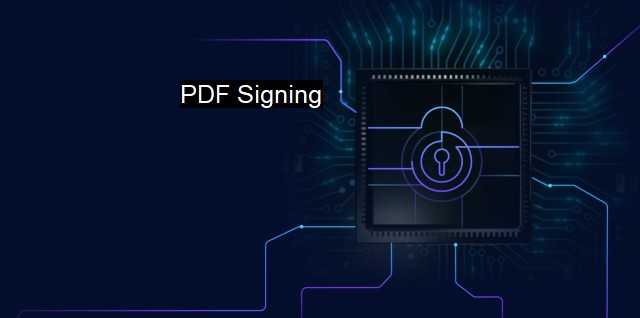What is PDF Signing?
Securing Your Digital Documents: The Power of PDF Signing in Cybersecurity
PDF Signing involves the use of digital signatures within the technology and cybersecurity landscape. It is crucial to highlight the critical way in which this mechanism primarily focuses on the enhancement of authenticity. When the term PDF Signing is mentioned, it refers to the validation of a document's originality, ensuring that its content remains tamper-proof while maintaining the document's integrity throughout its digital transmission processes.In the cybersecurity realm, PDF Signing is invaluable due to the increased instances of cyber threats, manipulations, and data breaches that continue to create immense challenges in today's digitally manipulated world. With digitally signed PDFs, users can ensure the authenticity of the sender while safeguarding themselves against the various pitfalls of the cyber world. It negates risks associated with traditional methods of communication, which are vulnerable to intercepts, manipulation, or the inclusion of harmful malware or viruses - often camouflaged within the transmitted document.
A PDF Signing procedure involves several actions. Initially, a document's owner, known as the signer, uses their private key to create a unique document hash which is then encrypted, forming the digital signature. This encrypted digital signature is attached to the document, which is then ready for transmission. On document receipt, the recipient uses the public key of the sender to decrypt and retrieve the original hash of the document. The recipient's system then generates its hash of the received document for comparison. Since a document's hash is unique, similar to a human fingerprint, any alteration in the document changes its hash. If the hashes do not tally, this indicates possible tampering.
The digital signature landscape has immense implications on antivirus systems. For instance, antivirus software often uses digital signatures to determine whether a particular piece of software or a document is malicious. This signature-based detection is a common and crucial antivirus technique that allows the system to compare known harmful signatures in a database to the signatures of files in the system.
Antivirus software also tags any digital signature that diverges from the known or trusted encryption keys as suspicious. More specifically, this technique aids cybersecurity by prompting an alert when a manipulated or affected file diverges from its original hash. In case of such discrepancies, the antivirus software quarantines the potential threat preventing further repercussions across an organization's network.
Certification authorities (CAs) also play a critical role in digital signatures. These are trusted entities that check and vouch for someone's identity before issuing a digital certificate that binds a public key with respective user identities. This approach ensures that individuals who receive the digitally signed PDFs are confident of the sender's tag.
From the premise of cybersecurity and antiviruses, PDF signing provides a superior way to maintain document integrity during transmission and assures the recipient about the sender's authenticity. By utilizing private and public encryption keys and hash algorithms, PDF signing helps prevent data breaches, manipulations, and unauthorized modifications. Also, due to their robust capability to single out harmful signatures, antivirus systems utilize signatures to eliminate malicious threats, making PDF Signing a vital tool in the current digital age.

PDF Signing FAQs
What is pdf signing?
PDF signing refers to the process of adding a digital signature to a PDF document to ensure its authenticity and integrity. The signature is encrypted and can only be decrypted by the intended recipient, making it a secure way to sign and share electronic documents.Why is pdf signing important in cybersecurity?
PDF signing is important in cybersecurity because it provides a way to identify the author of a document and ensure that the document has not been tampered with. This helps protect against cyber attacks such as phishing, malware, and data breaches.Can antivirus software detect malicious signatures in PDF documents?
Yes, antivirus software can detect and alert users to malicious signatures in PDF documents. It uses advanced algorithms and heuristics to analyze the digital signature and compare it with a database of known signatures. If it detects a signature that is associated with malware or other harmful content, it will flag the document and quarantine it.What are the benefits of using pdf signing for electronic transactions?
Using PDF signing for electronic transactions offers several benefits, including increased security, reduced risk of fraud, improved efficiency, and enhanced legal compliance. It eliminates the need for physical signatures and paperwork, making the process faster and more convenient for all parties involved. Additionally, PDF signing can help prevent disputes and litigation by providing a clear record of the transaction and the parties involved.| | A | | | B | | | C | | | D | | | E | | | F | | | G | | | H | | | I | | | J | | | K | | | L | | | M | |
| | N | | | O | | | P | | | Q | | | R | | | S | | | T | | | U | | | V | | | W | | | X | | | Y | | | Z | |
| | 1 | | | 2 | | | 3 | | | 4 | | | 7 | | | 8 | | |||||||